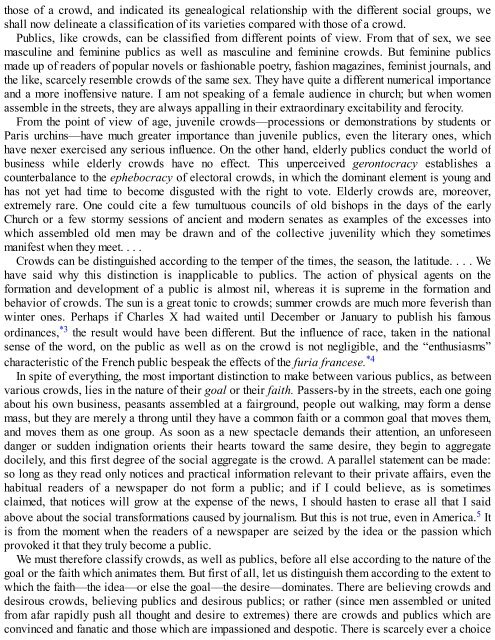3658925934
Create successful ePaper yourself
Turn your PDF publications into a flip-book with our unique Google optimized e-Paper software.
those of a crowd, and indicated its genealogical relationship with the different social groups, we<br />
shall now delineate a classification of its varieties compared with those of a crowd.<br />
Publics, like crowds, can be classified from different points of view. From that of sex, we see<br />
masculine and feminine publics as well as masculine and feminine crowds. But feminine publics<br />
made up of readers of popular novels or fashionable poetry, fashion magazines, feminist journals, and<br />
the like, scarcely resemble crowds of the same sex. They have quite a different numerical importance<br />
and a more inoffensive nature. I am not speaking of a female audience in church; but when women<br />
assemble in the streets, they are always appalling in their extraordinary excitability and ferocity.<br />
From the point of view of age, juvenile crowds—processions or demonstrations by students or<br />
Paris urchins—have much greater importance than juvenile publics, even the literary ones, which<br />
have nexer exercised any serious influence. On the other hand, elderly publics conduct the world of<br />
business while elderly crowds have no effect. This unperceived gerontocracy establishes a<br />
counterbalance to the ephebocracy of electoral crowds, in which the dominant element is young and<br />
has not yet had time to become disgusted with the right to vote. Elderly crowds are, moreover,<br />
extremely rare. One could cite a few tumultuous councils of old bishops in the days of the early<br />
Church or a few stormy sessions of ancient and modern senates as examples of the excesses into<br />
which assembled old men may be drawn and of the collective juvenility which they sometimes<br />
manifest when they meet. . . .<br />
Crowds can be distinguished according to the temper of the times, the season, the latitude. . . . We<br />
have said why this distinction is inapplicable to publics. The action of physical agents on the<br />
formation and development of a public is almost nil, whereas it is supreme in the formation and<br />
behavior of crowds. The sun is a great tonic to crowds; summer crowds are much more feverish than<br />
winter ones. Perhaps if Charles X had waited until December or January to publish his famous<br />
ordinances, *3 the result would have been different. But the influence of race, taken in the national<br />
sense of the word, on the public as well as on the crowd is not negligible, and the “enthusiasms”<br />
characteristic of the French public bespeak the effects of the furia francese. *4<br />
In spite of everything, the most important distinction to make between various publics, as between<br />
various crowds, lies in the nature of their goal or their faith. Passers-by in the streets, each one going<br />
about his own business, peasants assembled at a fairground, people out walking, may form a dense<br />
mass, but they are merely a throng until they have a common faith or a common goal that moves them,<br />
and moves them as one group. As soon as a new spectacle demands their attention, an unforeseen<br />
danger or sudden indignation orients their hearts toward the same desire, they begin to aggregate<br />
docilely, and this first degree of the social aggregate is the crowd. A parallel statement can be made:<br />
so long as they read only notices and practical information relevant to their private affairs, even the<br />
habitual readers of a newspaper do not form a public; and if I could believe, as is sometimes<br />
claimed, that notices will grow at the expense of the news, I should hasten to erase all that I said<br />
above about the social transformations caused by journalism. But this is not true, even in America. 5 It<br />
is from the moment when the readers of a newspaper are seized by the idea or the passion which<br />
provoked it that they truly become a public.<br />
We must therefore classify crowds, as well as publics, before all else according to the nature of the<br />
goal or the faith which animates them. But first of all, let us distinguish them according to the extent to<br />
which the faith—the idea—or else the goal—the desire—dominates. There are believing crowds and<br />
desirous crowds, believing publics and desirous publics; or rather (since men assembled or united<br />
from afar rapidly push all thought and desire to extremes) there are crowds and publics which are<br />
convinced and fanatic and those which are impassioned and despotic. There is scarcely ever a choice









![Genki - An Integrated Course in Elementary Japanese II [Second Edition] (2011), WITH PDF BOOKMARKS!](https://img.yumpu.com/58322134/1/180x260/genki-an-integrated-course-in-elementary-japanese-ii-second-edition-2011-with-pdf-bookmarks.jpg?quality=85)
![Genki - An Integrated Course in Elementary Japanese I [Second Edition] (2011), WITH PDF BOOKMARKS!](https://img.yumpu.com/58322120/1/182x260/genki-an-integrated-course-in-elementary-japanese-i-second-edition-2011-with-pdf-bookmarks.jpg?quality=85)





